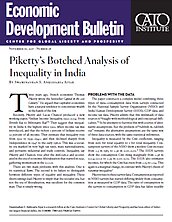Three years ago, French economist Thomas Piketty wrote the bestseller Capital in the 21st Century.1 He argued that capitalist economies have a natural tendency to concentrate wealth in the hands of the few.
Recently, Piketty and Lucas Chancel produced a new working paper, “Indian Income Inequality, 1922–2014: From British Raj to Billionaire Raj?”2 They suggest that inequality in India is the highest since 1922, when income tax was introduced, and that the richest 1 percent of Indians receive 22 percent of all income. They estimate that inequality rose from 1922 to 1939–1940, and then declined sharply from Independence in 1947 to the early 1980s. This was a socialist era marked by very high tax rates, mass nationalization, and pervasive industrial and trade controls. Inequality, say Piketty and Chancel, rose after the mid-1980s and accelerated in the era of economic liberalization that started in 1991, gathering momentum in the 2000s.
There are two main problems with this analysis. One is its statistical flaws. The second is its failure to distinguish between different types of equality and inequality. These shortcomings lead Piketty to imply that the socialist era, but not the era of liberalization, was excellent for the common man. That is simply wrong.

This work is licensed under a Creative Commons Attribution-NonCommercial-ShareAlike 4.0 International License.

